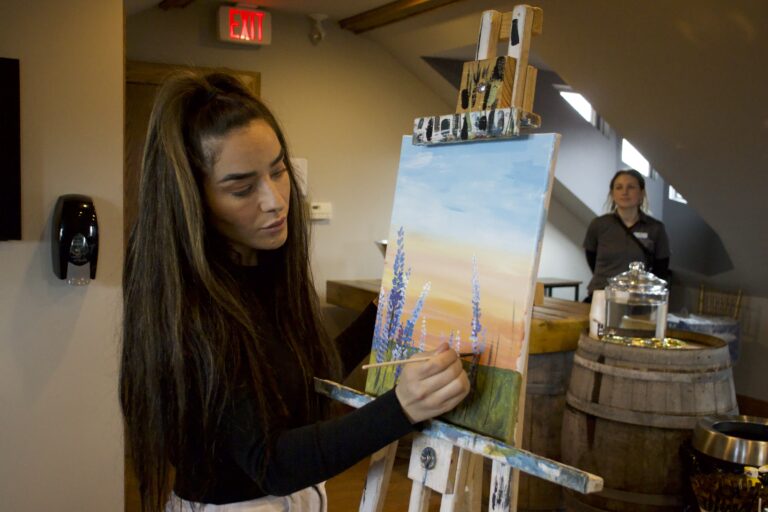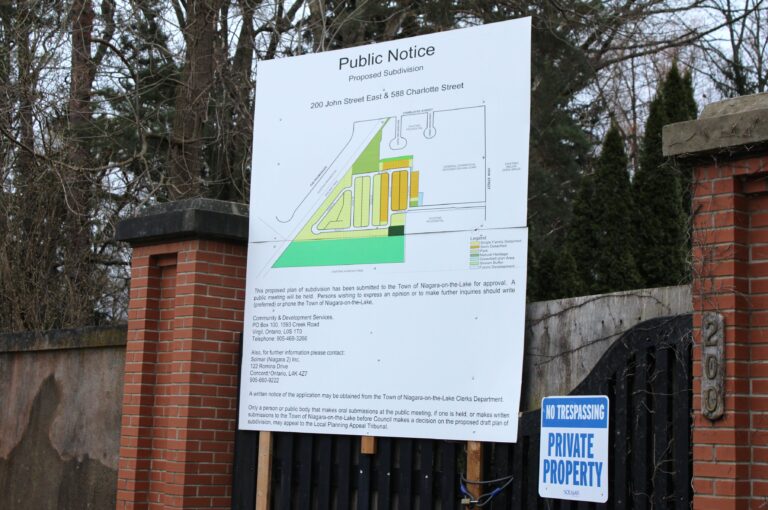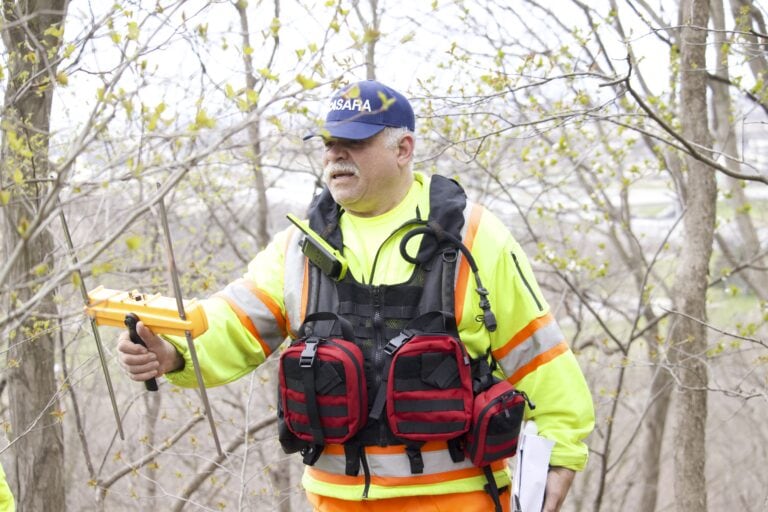Dariya Baiguzhiyeva
Denise Ascenzo
As one of the most historic towns in Canada, Niagara-on-the-Lake has plenty of hidden stories to tell.
Whether you’re in town for a special event, for Christmas shopping or for a getaway from big city hustle, consider taking a casual self-guided walkabout around the Old Town to learn about some of the historic places and buildings in town.
You can start the tour at Customs House, at 126 Queen St. If you look up, you’ll see a British Coat of Arms that reads “Dieu et Mon Droit” over the door. The coat of arms has been there for over a century, however, the one you see is a replica, which was installed in the 1980s during restoration works.
If you’re in a mood for a snack, treat yourself to something sweet at the Niagara Home Bakery.
Located at 66 Queen St., the bakery offers a wide range of British-inspired treats like Empire cookies, Eccles Cakes, Cornish pastries and traditional meat pies. Many items for sale in the store are imported from England.
The building, constructed by Mr. and Mrs. James (Jim) Swift around 1875, first started as an ice cream parlour.
Since the Swifts, there have been a number of owners. One of them was James MacPhee, who built a wood-burning stone oven in the back of the kitchen, and turned the ice cream place into a bakery.
The window casements are original and the display shelves in the front windows date back to MacPhee’s ownership.
At one point, the building was boarded up, but it reopened as a bakery in the late 1930s.
One of the long-standing business owners was the Albrechtson family who ran the business for more than 50 years and sold famous Long Johns doughnuts.
When the family was told that the fryer, which they used for making Long Johns, was no longer safe to use, they decided to stop the production of doughnuts. After a notice was put in the newspaper informing residents about the last day Long Johns would be on sale, residents lined up outside the bakery to buy one last Long John.
As you head out from the bakery, you will notice one of the famous NOTL landmarks towering over the street – the Clock Tower.
Designed by Toronto architect Charles Wilmot, the 42-foot tall clock tower, which is also the NOTL cenotaph, was unveiled in 1922. There are 10 names from the First World War and 18 names from the Second World War on the cenotaph. There has never been a bell in the tower but it once housed the town's fire alarm.
NOTL is the only town in Canada with a cenotaph in middle of the main street, as most cenotaphs are in parks off a main thoroughfare or in front of government offices.
Turn onto Regent Street, and on the corner of Regent and Johnson streets you will find the Voices of Freedom Park.
The park, which opened in November 2018, was designed to celebrate Niagara-on-the-Lake’s black history and tell the stories of people of African descent who lived and worked in NOTL.
There’s also a free self-guided walking tour app, complementing the park, which lets users learn more about the town’s black history. The app is called BaladoDiscovery Tours Guides which can be downloaded on the App Store or Google Play.
Return to Queen Street and on your right, you will see one of the most impressive buildings on Queen Street – The Court House.
Built in 1847, the Classical Revival structure was designed by arhictect William Thomas. Some of his other works include Grace United Church and Brock’s Monument in NOTL, St. Michael’s Cathedral Basilica, St. Lawrence Hall and the Don Jail in Toronto.
The Court House included courtrooms, prisoner cells, a market hall and a speaker’s balcony. When by the mid-1850s, the county seat was moved to St. Catharines, the building sat empty for many years.
It is now owned by the Town of NOTL and houses offices for Parks Canada, the NOTL Chamber of Commerce and the Grand Ballroom which is used for reception, conferences and for theatrical productions.
As you go past the LCBO, consider this interesting fact about the store. During the War of 1812, the American forces occupied the town from May of 1813 to December of 1813. Upon their retreatm they burned the town to the ground. The first building to be built on Queen Street after the fire was a stationery store by William Duff Miller. A second storey was added to the building in 1855.
By 1928, the Liquor Control Board of Ontario bought the building and opened the town’s first liquor store, which was renovated in 1973. One can only imagine how Miller, a staunch Presbyterian, would react to liquor being sold in his store!
Right next to the LCBO is The Owl and Pussycat store. Look up and notice the pineapple mounted on the front of the building.
The pineapple is a symbol of friendship and hospitality that was once used to welcome people into your home. Later it signified that the building was an establishment for food and lodging. Signs like these were often used to assist people who could not read to know what was being offered inside the building.
Other interesting feature is the muntins, which are thin vertical or horizontal bars between panels of glass. They can be made from wood or metal. The ones on the Owl and Pussycat are wooden and if you look closely you will see there are pineapples carved into the muntins at the top of all six frames.
Before you cross the intersection, leading toward the Prince of Wales Hotel, pay close attention to the street sign and notice how the name of Queen Street changes to Picton Street. The reason for that? Because “No street shall cross the King.”
At the corner of King and Picton streets is the Prince of Wales Hotel, which has had a varied and colourful history.
Built in 1881, it was bought and renamed the Niagara House by P. J. O’Neil. The current name of the hotel, Prince of Wales, appeared after the visit of the Duke and Duchess of York, who were later crowned King George V and Queen Mary.
What started as a simple hotel with rooms renting for $6 per night, turned into a hotel with “working girls” during the Depression era and eventually became the grand hotel you see today.
In 1998, Si Wai Lai's family purchased the hotel and renovated it. Walk inside the lobby and you will see wood inlay floors, plaster sculpted ceilings, a 10,000-piece stained glass wall, an ivory carving from China made in the 1600s and the walls that were authentically finished in the Victorian era Lincrusta method.
Down Picton Street, turn left to cross the intersection toward St. Vincent de Paul Catholic Church.
The first church was built in 1834 to meet the demand of the Irish Catholics who, after fleeing the Great Potato Famine in Ireland, needed a place of worship.
An addition to the church was built in the 1960s. As you walk down Wellington Street, past the graveyard, you will notice a huge area behind the church that looks unused. This is the paupers' grave, a place for the burial of unknown or indigent people. It is unknown how many people are buried there, but it is known that two criminals, who were hung, are resting in this section.
When you turn left to Byron Street, you will see a military gravesite for Polish soldiers who died from influenza while training at Niagara Camp from 1917 to 1919. Twenty-four Poles and a priest are buried at the site, which is a focus of an annual pilgrimage in June for members of the Polish communities from the United States and Canada. If you step inside the enclosed cemetery, you’re considered to be on Polish soil, as Canada ceded the land to Poland after the First World War.
Down the street, on your right, you will find one of the prettiest churches in NOTL – St. Mark’s Anglican Church.
One interesting fact: the graveyard, which was a general gravesite for all denominations, was in use before the church was built. Beside the church sits Addison Hall, built in 1866. It was used as a Sunday school, a meeting room and a library. The library has some of the oldest books in the province, with one book dating back to 1548. The parsonage is next to Addison Hall.
When you arrive at King Street, notice how the name of Byron Street has changed to Prideaux Street, because off that regal rule: “No street shall cross the King.”
Turn left, walk down the street a bit and you will see a beautiful Victorian house on the right side of King Street. It has quite a story behind it.
The house was built in 1880 by Samuel Rowley, a glass manufacturer from Philadelphia for his wife Fanny. She was a granddaughter of William Riley, an escaped slave from Virginia who arrived in NOTL in 1802.
Fanny met Rowley when she was working in a local barbershop. Their marriage raised the eyebrows of many people but it was nothing compared to when it was revealed that Rowley was already married and had a family back in Philadelphia. Being a philanderer might have been acceptable but being a bigamist was a greater sin in Victorian times.
After Fanny was free of her marriage, she sold the house on King Street and moved to the United States.
Feeling tired yet? Take a break in picturesque Simcoe Park at the corner of King and Picton streets. Named after John Graves Simcoe, Upper Canada’s first lieutenant-governor, the park also has a garden tucked within it, with Simcoe’s statue. Featuring a band shell that is used on summer weekends for various performances, the park is also equipped with washrooms, picnic tables, a playground and a wading pool.
Now back to Queen Street.
Right on the corner sits the Niagara Apothecary. The first pharmacist to open the pharmacy was Henry Paffard, who was also the longest-standing lord mayor of the town, serving for 23 years. The last pharmacist, Erland Field, closed the store in 1964. The pharmacy reopened as a museum in 1971 and is now maintained and run by the Ontario College of Pharmacy.
Notice the mortar and pestle over the front door. It is the original from when Paffard owned the building. Another visual symbol to let people who couldn’t read know that this was the place where they could buy medicines.
Next to the Apothecary there is a small building that used to be a Bell Telephone Exchange. When Hugh Baker Jr., a Hamilton businessman, saw Alexander Graham Bell’s phone invention in 1876, Baker decided to establish his own company. The Hamilton Telephone Company, which later became the Bell Telephone Company of Canada, extended from Hamilton to Wentworth, Halton, Halimand and Lincoln (NOTL was in Lincoln).
The building has had many uses over the years and is now home to the Exchange Brewery.
As your self-guided tour comes to an end, it may be time for food. You can stop by Corks Wine Bar and Eatery, which has quite a sad story when it was once (was) a private home.
Lloyd and Kate Burn lived in this house built in the 1850s. Kate’s parents died, leaving her to care for her brother Philip who was likely schizophrenic. When Lloyd married Kate, they agreed to let Philip live in the basement of their home.
One day, Philip managed to escape from the basement. In a hurry, he ran up the stairs and collided with his sister Kate, who lost her balance and fell down the basement stairs, breaking her neck.
In his agitated state, Philip felt his sister’s death was Lloyd's fault so Philip grabbed a kitchen knife, went upstairs and killed Lloyd.
When Philip went back down the basement to help his sister, he realized Kate was dead. In a distraught and panicked state of mind, Philip buried his sister and brother-in-law in the basement. He was found dead by his neighbours two days later. Some say he died from a broken heart.
To this day, people say they hear noises of someone falling down the basement stairs, shadows lurking in hallways, music coming from upstairs, the sounds of furniture moving – and sometimes restaurant staff tripping over unseen obstacles.
There are plenty of historic places and buildings to see in Niagara-on-the-Lake. For more in-depth information and tours, you can visit the Niagara-on-the-Lake Museum and Old Town Tours.
From June to September, the NOTL Museum holds guided tours through town starting at 11 a.m. at the gazebo at Queen’s Royal Park on Saturdays and Sundays. The museum can be reached at contact@nhsm.ca or 905-468-3912.
Old Town Tours offers private daily tours. For more information, contact info@oldtowntours.ca or 1-888-492-3532.











